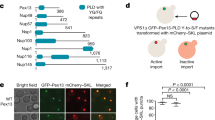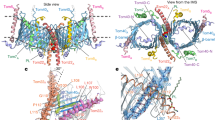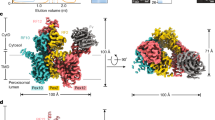Abstract
The peroxisomal protein import machinery differs fundamentally from known translocons (endoplasmic reticulum, mitochondria, chloroplasts, bacteria) as it allows membrane passage of folded, even oligomerized proteins1. However, the mechanistic principles of protein translocation across the peroxisomal membrane remain unknown. There are various models that consider membrane invagination events, vesicle fusion or the existence of large import pores. Current data show that a proteinaceous peroxisomal importomer enables docking of the cytosolic cargo-loaded receptors, cargo translocation and receptor recycling2. Remarkably, the cycling import receptor Pex5p changes its topology from a soluble cytosolic form to an integral membrane-bound form. According to the transient pore hypothesis, the membrane-bound receptor is proposed to form the core component of the peroxisomal import pore3. Here, we demonstrate that the membrane-associated import receptor Pex5p together with its docking partner Pex14p forms a gated ion-conducting channel which can be opened to a diameter of about 9 nm by the cytosolic receptor–cargo complex. The newly identified pore shows striking dynamics, as expected for an import machinery translocating proteins of variable sizes.
This is a preview of subscription content, access via your institution
Access options
Subscribe to this journal
Receive 12 print issues and online access
$209.00 per year
only $17.42 per issue
Buy this article
- Purchase on Springer Link
- Instant access to full article PDF
Prices may be subject to local taxes which are calculated during checkout




Similar content being viewed by others
References
Schnell, D. J. & Hebert, D. N. Protein translocons: multifunctional mediators of protein translocation across membranes. Cell 112, 491–505 (2003).
Agne, B. et al. Pex8p: an intraperoxisomal organizer of the peroxisomal import machinery. Mol. Cell 11, 635–646 (2003).
Erdmann, R. & Schliebs, W. Peroxisomal matrix protein import: the transient pore model. Nature Rev. Mol. Cell Biol. 6, 738–742 (2005).
Walton, P. A., Hill, P. E. & Subramani, S. Import of stably folded proteins into peroxisomes. Mol. Biol. Cell 6, 675–683 (1995).
Gould, S. J. & Collins, C. S. Peroxisomal-protein import: is it really that complex? Nature Rev. Mol. Cell Biol. 3, 382–389 (2002).
Lemmens, M. et al. Single-channel analysis of a large conductance channel in peroxisomes from rat liver. Biochim. Biophys. Acta 984, 351–359 (1989).
Labarca, P., Wolff, D., Soto, U., Necochea, C. & Leighton, F. Large cation-selective pores from rat liver peroxisomal membranes incorporated to planar lipid bilayers. J. Membr. Biol. 94, 285–291 (1986).
Stanley, W. A. et al. Recognition of a functional peroxisome type 1 target by the dynamic import receptor pex5p. Mol. Cell 24, 653–663 (2006).
Schliebs, W. & Kunau, W. H. PTS2 co-receptors: diverse proteins with common features. Biochim. Biophys. Acta 1763, 1605–1612 (2006).
Platta, H. W. & Erdmann, R. Peroxisomal dynamics. Trends Cell Biol. 17, 474–484 (2007).
Gouveia, A. M., Reguenga, C., Oliveira, M. E., Sa-Miranda, C. & Azevedo, J. E. Characterization of peroxisomal Pex5p from rat liver. Pex5p in the Pex5p-Pex14p membrane complex is a transmembrane protein. J. Biol. Chem. 275, 32444–32451 (2000).
Platta, H. W. et al. Ubiquitination of the peroxisomal import receptor Pex5p is required for its recycling. J. Cell Biol. 177, 197–204 (2007).
Platta, H. W., Grunau, S., Rosenkranz, K., Girzalsky, W. & Erdmann, R. Functional role of the AAA peroxins in dislocation of the cycling PTS1 receptor back to the cytosol. Nature Cell Biol. 7, 817–822 (2005).
Miyata, N. & Fujiki, Y. Shuttling mechanism of peroxisome targeting signal type 1 receptor Pex5: ATP-independent import and ATP-dependent export. Mol. Cell Biol. 25, 10822–10832 (2005).
Elgersma, Y. et al. Analysis of the carboxy-terminal peroxisomal targeting signal 1 in a homologous context in Saccharomyces cerevisiae. J. Biol. Chem. 9, 185–197 (1996).
Smart, O. S., Breed, J., Smith, G. R. & Sansom, M. S. A novel method for structure-based prediction of ion channel conductance properties. Biophys. J. 72, 1109–1126 (1997).
Neupert, W. & Herrmann, J. M. Translocation of proteins into mitochondria. Annu. Rev. Biochem. 76, 723–49 (2007).
Hill, K. et al. Tom40 forms the hydrophilic channel of the mitochondrial import pore for preproteins [see comment]. Nature 395, 516–521 (1998).
Meinecke, M. et al. Tim50 maintains the permeability barrier of the mitochondrial inner membrane. Science 312, 1523–1526 (2006).
Wirth, A. et al. The Sec61p complex is a dynamic precursor activated channel. Mol. Cell 12, 261–268 (2003).
Kovermann, P. et al. Tim22, the essential core of the mitochondrial protein insertion complex, forms a voltage-activated and signal-gated channel. Mol. Cell 9, 363–373 (2002).
Hinnah, S. C., Hill, K., Wagner, R., Schlicher, T. & Soll, J. Reconstitution of a chloroplast protein import channel. EMBO J. 16, 7351–7360 (1997).
Heins, L. et al. The preprotein conducting channel at the inner envelope membrane of plastids. EMBO J. 21, 2616–2625 (2002).
Rehling, P. et al. Pex8p, an intraperoxisomal peroxin of Saccharomyces cerevisiae required for protein transport into peroxisomes binds the PTS1 receptor Pex5p. J. Biol. Chem. 275, 3593–3602 (2000).
Titorenko, V. I., Nicaud, J. M., Wang, H., Chan, H. & Rachubinski, R. A. Acyl-CoA oxidase is imported as a heteropentameric, cofactor-containing complex into peroxisomes of Yarrowia lipolytica. J. Cell Biol. 156, 481–494 (2002).
Rehling, P. et al. Protein insertion into the mitochondrial inner membrane by a twin-pore translocase. Science 299, 1747–1751 (2003).
Azevedo, J. E. & Schliebs, W. Pex14p, more than just a docking protein. Biochim. Biophys. Acta 1763, 1574–1584 (2006).
Carvalho, A. F. et al. The N-terminal half of the peroxisomal cycling receptor Pex5p is a natively unfolded domain. J. Mol. Biol. 356, 864–875 (2006).
Kerssen, D. et al. Membrane association of the cycling peroxisome import receptor Pex5p. J. Biol. Chem. 281, 27003–27015 (2006).
Salomons, F. A., Kiel, J. A., Faber, K. N., Veenhuis, M. & van der Klei, I. J. Overproduction of Pex5p stimulates import of alcohol oxidase and dihydroxyacetone synthase in a Hansenula polymorpha Pex14 null mutant. J. Biol. Chem. 275, 12603–12611 (2000).
Grunau, S. et al. Peroxisomal targeting of PTS2-pre-import complexes in the yeast Saccharomyces cerevisiae. Traffic 10, 451–460 (2009).
van der Laan, M. et al. Motor-free mitochondrial presequence translocase drives membrane integration of preproteins. Nature Cell Biol. 9, 1152–9 (2007).
Acknowledgements
This work was supported by grants from the Deutsche Forschungsgemeinschaft SFB431 (M.M. and R.W.), SFB642 (R.E.), DFGSchl 584/1-2 (WS) and the Fonds der Chemischen Industrie. We thank Wolf Kunau for helpful comments and discussion.
Author information
Authors and Affiliations
Contributions
M.M. and V.K. performed all electrophysiological measurements and analysed data; C.C. and S.B. prepared and analysed the samples and reconstituted them into proteoliposomes; M.M., W.S., R.W. and R.E. designed the study and wrote the manuscript.
Corresponding author
Ethics declarations
Competing interests
The authors declare no competing financial interests.
Supplementary information
Supplementary Information
Supplementary Information (PDF 2989 kb)
Rights and permissions
About this article
Cite this article
Meinecke, M., Cizmowski, C., Schliebs, W. et al. The peroxisomal importomer constitutes a large and highly dynamic pore. Nat Cell Biol 12, 273–277 (2010). https://doi.org/10.1038/ncb2027
Received:
Accepted:
Published:
Issue Date:
DOI: https://doi.org/10.1038/ncb2027
This article is cited by
-
Modulation of peroxisomal import by the PEX13 SH3 domain and a proximal FxxxF binding motif
Nature Communications (2024)
-
The peroxisome: an update on mysteries 3.0
Histochemistry and Cell Biology (2024)
-
Peroxisome biogenesis initiated by protein phase separation
Nature (2023)
-
Cooperativity of membrane-protein and protein–protein interactions control membrane remodeling by epsin 1 and affects clathrin-mediated endocytosis
Cellular and Molecular Life Sciences (2021)
-
Unlocking the door for ERAD
Nature Cell Biology (2020)



